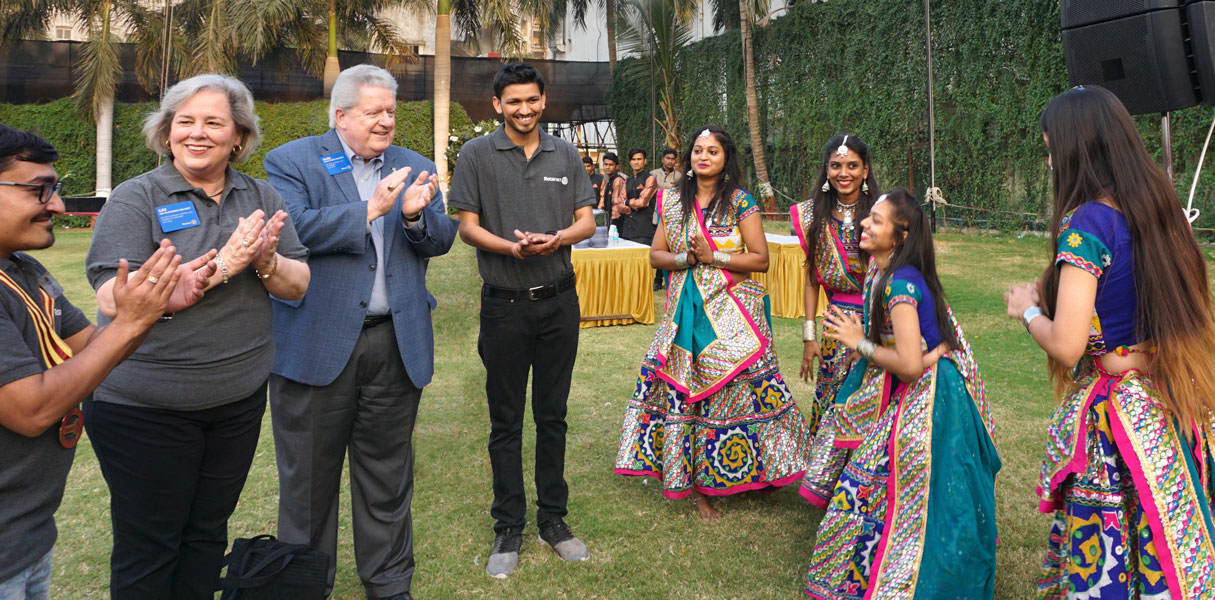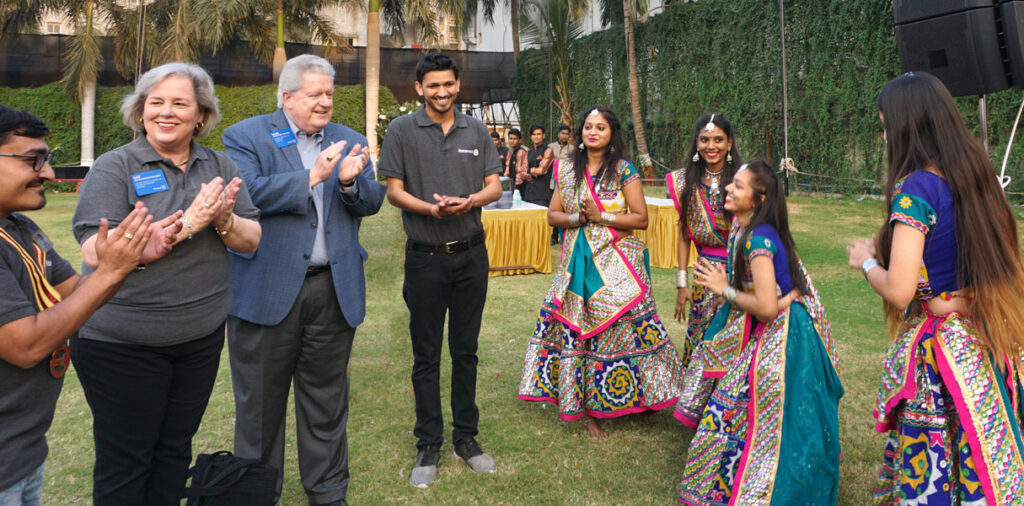RIPE Mark Maloney and Gay, on their recent visit to Surat, Gujarat, had a look at various service projects in D 3060.

Excerpts from the specially arranged talk show — Rotaraction — where Maloney interacted with Rotaractors. The event was anchored by Past DRR Nirav Trivedi.
Nirav Trivedi: What difference do you find between your visits to District 3060 in the past and now?
Mark Maloney: The difference in Surat, which I last visited in 2004, is tremendous. Today we went to the village Niyol, where I had inaugurated a water project which was well outside the city, but now it is right on the edge of the city, where I find a lot of development. When Himanshu (PDG Himanshu Thacker) first came to Surat in the mid-1970s, the population of Surat was 300,000; now it is six million. The buildings, structures, the drive up to the hotel and the neighbourhood have all changed and the Rotary service here is tremendous.
We don’t monitor the Rotaract activities.
Today Gay and I had the opportunity to visit six different projects, including the water project in Niyol and they are all great.
Trivedi: Should Rotaract focus more on professional leadership development or community service?
Maloney: Both; I don’t think you can focus on one aspect exclusive of the other. The same thing happens in Rotary. We provide recognitions for contribution to TRF, but not to hours of service in community and international projects. Perhaps that’s something that we have to do. It’s so much easier to recognise the amount in rupees than calculate the hours of service. So we tend to take the easier path. But in terms of Rotaract I think that if you ignore the professional leadership training then you leave behind that aspect of Rotaract that may be attractive to young adults. I think the focus should not only be on service but also improving ourselves.
Rotary International is not good in collecting data about Rotaract.
Trivedi: What differentiates Rotaract in India from other countries?
Maloney: I am just beginning my travel and don’t think I have a broad base of experience to make that comparison. In the US, Rotaract is not a strong activity. You cannot see the number of Rotaract clubs that you see in India. In my own district, we have one extremely strong Rotaract club — the Rotaract Club of Birmingham Alabama — which claims to be the world’s largest Rotaract club. I don’t know if that is true or not. They have 350 members and it is a community-based club and the waiting list to get into the club rivals the waiting list of RC Birmingham itself!
I am extremely impressed with Rotaract in India, and you have a large number of Rotaract clubs. We don’t know how many Rotaract clubs are there. RI is not good in collecting data about Rotaract. But we know that there must be thousands and thousands of Rotaractors sponsored by Rotary clubs in this country. I applaud the Rotaractors of India for their impressive projects.
Trivedi: So how does RI monitor Rotaract data and activities?

Maloney: We don’t monitor Rotaract activities. That’s the problem. President Barry Rassin wants to change that. There are 200,000 Rotaractors around the world. We need to improve our data collection and create a partnership with Rotaractors.
For the very first time in Rotary history we’re inviting 60 Rotaractors to attend the 2019 International Assembly in San Diego.
This is a two-sided invitation and has two reasons. One, a selfish reason, is that the Rotaractors share their thoughts with the governors-elect and give them some idea of what younger business and professional leaders are looking for in community and international humanitarian service.
The second objective is to provide those Rotaractors with an opportunity to partner and develop international connections and bring ideas back to their districts. Only 60 districts will have Rotaract representation at the IA but it is a beginning and will help to develop more partnership between Rotary and Rotaract.
We shouldn’t have retired individuals as district governor every year.
This is an idea that came spontaneously. At the last IA, in his theme address President Barry focused on Rotaract and the need to double its numbers. And my aide PRID Larry Langford said: ‘Why don’t we invite Rotaractors to next year’s Assembly?’ And over the course of the week, we talked it through. On the last day of the Assembly, the staff responsible for organising the Assembly meet with the President-nominee to hear his thoughts and ideas for the next Assembly. I shared the idea but was a little nervous as it meant 50–100 extra air tickets and hotel rooms. I thought some of the staff would fall off their chairs hearing this! But they didn’t. They were very professional, took down notes and we had to figure out how to select the Rotaract representatives.
The number 60 is the magic number. It was worked so that in our group discussion rounds we will have two Rotaractors in each group. So we are moving forward and we’ll see how the future develops and let’s see what President-nominee Sushil (Gupta) thinks about Rotaractors at the IA.
Trivedi: What new initiatives can Rotaractors expect from RI?
Maloney: You are going to see a continuation of President Barry’s attitudes towards Rotaract, and a methodical analysis of how we can improve our information about Rotaract. This goes back to the data collection issue and a proposal to charge a small amount as dues for RI from Rotaractors. If they pay the dues, that gets reported and helps with data collation.
The President of Rotary International is not a very powerful figure. The President is to a certain extent, as we call it in the US, a cheer leader.
Trivedi: The Rotaract Handbook does not mention anything about DRR’s official visits to clubs. It actually says that Rotaract clubs should report to the sponsoring Rotary club president and the DRCC without any mention of reporting to the DRR. So how do you think the DRRs can monitor the activities of Rotaract clubs and urge them to do meaningful projects and work towards the goals of Rotary and Rotaract?
Maloney: I’ll be frank. I have never laid eyes on the Rotaract Handbook, and so have no idea what it says. My history does not include a lot of involvement with Rotaract because of the part of the world that I am from. I suppose this is a problem in India because of the attitude that Rotaract is a programme of Rotary, therefore, they have to report back to the club president and the DRCC. Not many districts have a DRR. I think there should be a minimum number of Rotaract clubs before you could have a DRR, according to the Handbook.
In many States, there are no DRRs, and if there is a DRR, there is not a lot of function or communication among Rotaract clubs and this needs to be addressed.
Pictures by Jaishree
Let’s get younger leaders
Answering a question from the audience RIPE Maloney said he did not think that Rotaractors faced “resistance” from local Rotary clubs. This might be an exception and not the rule. “Only in recent years, Rotary is beginning to realise that we have a problem in attracting younger business and professional leaders into the organisation. We have to adjust to changing times. We do things in Rotary that made sense a long time ago and hence became traditional.”
He said during his tenure he would work to make “Rotary leadership accessible to those still actively engaged in their business or profession. I don’t think that it is the same issue in India. But there are many parts of the world where Rotarians absolutely were not considered for district governorship until after their retirement. And if the leadership consisted of mostly retired individuals, it sets a mood, provides an image that Rotary is an older organisation. I am not saying we shouldn’t have retired individuals as DGs. But I am saying we shouldn’t have retired individuals as DGs every year.”
He added that in his district in North Alabama, 29 years ago they had a DG who was 34 years old. “That was me. And seven years later, we had a DG who was 42. That was my law partner Ken Schuppert. But when you look at the past, maybe 10 years, every DG in my district is a retired person. They waited until their retirement to become DGs. And we have realised that younger individuals who are actively engaged in their businesses or professions can assume leadership. We keep asking Rotary leaders to do more and more — more training meetings, more functions, more duties. We have got to streamline what we do.
RIPN Sushil Gupta says “we’ve got to simplify Rotary.” That’s his way of describing it. Even in India, the visit of the DG to a Rotary club is a festival event. I guarantee you, it’s not a festival in the US. Many Rotarians in the US would just not want the DG to come because they are afraid that he would give a boring speech. It wasn’t necessary for a DG to visit all clubs. If we want to attract younger members, can we reasonably expect that they leave their jobs 50 days a year to visit 50 clubs in the district? Your DG ( Pinky Patel) is obviously not retired. She is a young individual. There are such exceptions.”
We have to do things that can make Rotary look attractive to the younger generation, he added.






